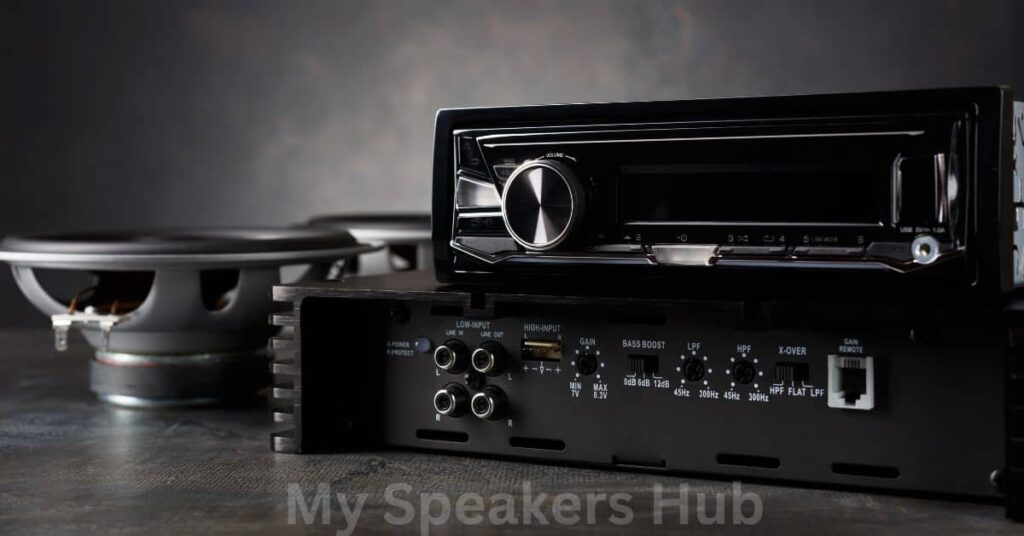Are you looking to expand your audio setup? Connecting a powered subwoofer to your passive speakers can give your audio system more depth and create a fuller sound. In this guide, we’ll walk you through the steps needed to connect a powered subwoofer to passive speakers, so you can get the most out of your audio system.
Step-by-Step Guide to Connect a Powered Subwoofer to Passive Speakers
- Determine the type of connection that your powered subwoofer and passive speakers require. The most common connection types are RCA, 3.5mm, or Speakon.
- Connect the RCA or 3.5mm cable from the subwoofer’s output to the speaker’s input. For a Speakon connection, plug the male end of the Speakon cable into the subwoofer’s output and the female end into the speaker’s input.
- Connect the speaker cables from the passive speakers to the powered subwoofer’s input. Check the user manual for the subwoofer to determine which speaker terminals to use.
- Power on the subwoofer and turn the volume to the desired level.
- Power on the passive speakers and adjust the volume to the desired level.
- Test the sound by playing music through the system. Make sure to listen for any distortion or clipping of the sound.
- Adjust the crossover frequency of the subwoofer, if necessary. The crossover frequency determines which frequencies the subwoofer will reproduce and which frequencies the passive speakers will reproduce. Check the user manual for the subwoofer for instructions on how to adjust the crossover frequency.
- Adjust the phase of the subwoofer, if necessary. The phase determines how the subwoofer and passive speakers interact with each other. Check the user manual for the subwoofer for instructions on how to adjust the phase.
Understanding the Basics: What is a Powered Subwoofer and How Does it Work
A powered subwoofer is a specialized speaker designed to produce low frequency sounds, or bass. It typically consists of a large driver (the speaker itself) housed in an enclosure, along with an amplifier. The amplifier is designed to amplify the low frequency signals and power the subwoofer’s driver. The amplifier and driver combination provide a much louder and fuller bass response than a traditional speaker.
The powered subwoofer is usually connected to a receiver, such as a home theater system, and is controlled by the receiver’s bass control settings. This allows the user to adjust the amount of bass the subwoofer produces, as well as its frequency response. A powered subwoofer is also more efficient than a passive subwoofer, meaning that it can produce more bass with less power.

Powered subwoofers are a great way to enhance the sound of a home theater system, providing a fuller and more immersive sound experience. They are also an excellent choice for music listening, as they can provide a deeper and more realistic sound with less distortion.
Different Methods of Connecting a Powered Subwoofer to Passive Speakers
There are several different methods for connecting a powered subwoofer to passive speakers. The method you choose will depend on the type of equipment you have and your desired audio setup.
The most common method is to connect the powered subwoofer to the amplifier or receiver via a dedicated subwoofer output. This output is usually labeled as subwoofer or LFE (Low Frequency Effects). The powered subwoofer is then connected to the passive speakers via speaker cable. This will ensure the powered subwoofer is receiving the full signal from the amplifier or receiver.
Another option is to connect the powered subwoofer to the passive speakers via a line-level connection. This connection is usually made using RCA cables or speaker wire. This method is beneficial if the powered subwoofer has its own amplifier and is designed to be used with passive speakers.
Finally, if your powered subwoofer has a built-in high-pass filter, you can connect it directly to the passive speakers without the need for additional cables or amplifiers. This method is ideal for smaller systems where space is limited.
Troubleshooting Tips for Connecting a Powered Subwoofer to Passive Speakers
When connecting a powered subwoofer to passive speakers, there are a few troubleshooting tips to keep in mind. Firstly, make sure the impedance of the subwoofer and the speakers are compatible; the subwoofer should have an impedance that is double that of the speakers. Additionally, ensure that the subwoofer is connected to the correct output of the amplifier; it should be connected to the subwoofer output. Further, make sure the signal cables are connected properly; the left and right channels should be connected to their respective speaker outputs. Finally, check the settings on your amplifier and subwoofer. Make sure the amplifier is set to “subwoofer” or “LFE” and the subwoofer is set to “on.” Following these tips should help ensure that your powered subwoofer is connected to your passive speakers correctly.
Benefits of Adding a Powered Subwoofer to Passive Speakers
A powered subwoofer can be a great addition to a passive speaker setup. Powered subwoofers contain an amplifier, allowing them to achieve greater bass than a passive subwoofer. This also allows for more precise control over the level and quality of bass output. With this added control, you can easily adjust the bass to your liking and create the perfect soundscape for your listening experience. Additionally, a powered subwoofer can help to fill in the lower frequency range that is often missing from passive speakers. This can make for a fuller, more immersive sound. Additionally, a powered subwoofer can also help to increase the overall volume of the sound system. By adding a powered subwoofer to your passive speaker setup, you can enjoy a wide range of benefits and take your listening experience to the next level.
How to Choose the Right Powered Subwoofer for your Passive Speakers
When choosing a powered subwoofer for your passive speakers, there are several factors to consider.
First, you need to determine the overall size of your subwoofer. The size of the subwoofer will help determine how much bass output it can produce. If your room is large, you may want to opt for a larger subwoofer, as it will be able to send more bass to the room. If your room is small, you may want to opt for a smaller subwoofer, as it will be able to send less bass to the room.
Second, you need to consider the type of subwoofer that you want. There are several different types of subwoofers available, including sealed, vented, and bandpass designs. Each type of subwoofer has its own advantages and disadvantages, so it is important to research each type to determine which is the best choice for your needs.
Third, you need to determine the power output of the subwoofer. This will help you determine how much bass output the subwoofer can produce. If you are looking for a subwoofer that can produce a lot of bass, then you should look for one with a higher power output.
Frequently Asked Questions[FAQs]
What is a powered subwoofer?
A powered subwoofer is an audio device that consists of a subwoofer speaker and an amplifier, all in one unit. The subwoofer is typically a large, low frequency speaker that produces bass tones, and the amplifier is used to boost the signal to the subwoofer. Powered subwoofers are designed to be used with existing speakers to provide greater bass response and overall sound quality.
What do I need to connect a powered subwoofer to passive speakers?
To connect a powered subwoofer to passive speakers, you will need at least one RCA cable and two speaker cables. A 3.5mm to RCA cable can also be used if your powered subwoofer only has a 3.5mm port. Additionally, you will need to make sure that the impedance of your passive speakers and powered subwoofer are compatible.
How do I connect a powered subwoofer to passive speakers?
To connect a powered subwoofer to passive speakers, start by connecting the RCA cables to the powered subwoofer and the audio source. Then, connect the speaker cables to the passive speakers and the powered subwoofer. Finally, use the gain control on the subwoofer to adjust the bass level.
What is the difference between a passive and active subwoofer?
The main difference between a passive and active subwoofer is that an active (or powered) subwoofer has an amplifier built into the unit. As a result, an active subwoofer requires a power source in order to function, while a passive subwoofer does not. Additionally, an active subwoofer is typically more powerful than a passive subwoofer.
What is the best way to connect a subwoofer to passive speakers?
The best way to connect a subwoofer to passive speakers is to use an RCA cable and two speaker cables. Additionally, it is important to make sure that the impedance of your passive speakers and powered subwoofer are compatible.
Can I use an RCA cable to connect a powered subwoofer to passive speakers?
Yes, you can use an RCA cable to connect a powered subwoofer to passive speakers. However, you will need to make sure that the RCA cable is compatible with the powered subwoofer, as some powered subwoofers may require a 3.5mm to RCA cable.
What is impedance and why is it important when connecting a subwoofer to passive speakers?
Impedance is a measure of resistance within an electrical circuit, and it is important to consider when connecting a subwoofer to passive speakers. If the impedance of the subwoofer and the passive speakers are not compatible, the subwoofer may not be able to produce the desired sound quality.
Is there a way to adjust the bass level when connecting a powered subwoofer to passive speakers?
Yes, most powered subwoofers have a gain control that can be used to adjust the bass level. When connecting the subwoofer to passive speakers, you can use the gain control to adjust the bass level to your liking.
Conclusion
Connecting a powered subwoofer to passive speakers can greatly improve sound quality and is a great way to upgrade your listening experience. However, it is important to make sure you have the right cables and connections to ensure a successful setup. With the right connections and a few simple steps, you can easily connect a powered subwoofer to passive speakers and enjoy a richer, fuller sound.


